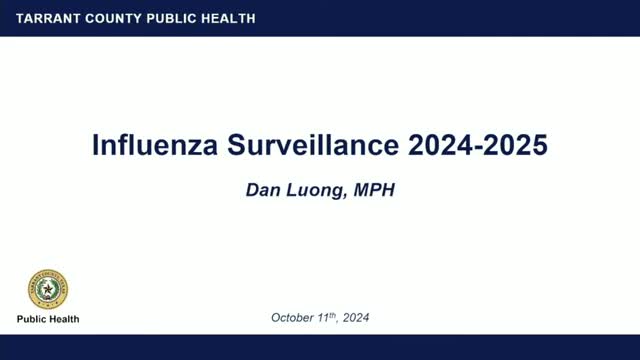Flu season insights reveal alarming trends and new risks
October 11, 2024 | KELLER ISD, School Districts, Texas
This article was created by AI summarizing key points discussed. AI makes mistakes, so for full details and context, please refer to the video of the full meeting. Please report any errors so we can fix them. Report an error »

During a recent government meeting, Dan, the influenza surveillance specialist for Tarrant County Public Health, provided an in-depth overview of the previous and current flu seasons, highlighting key statistics and trends that could impact public health strategies.
The last flu season, which ran from October 1, 2023, to May 18, 2024, saw a notable increase in flu activity, with two significant peaks occurring in early December and late January. Tarrant County reported a flu positivity rate of 9.7% from 220,444 tests conducted, with a nearly even split between influenza A (53.3%) and B (46.7%). This marked a significant shift from previous seasons, which typically saw a predominance of influenza A cases.
Looking ahead, the current flu season began on September 29, 2024, with a baseline positivity rate similar to last year’s at 6.5%. This year’s flu vaccine has transitioned to a trivalent formulation, omitting the Yamagata strain of influenza B, which has not circulated since 2020. The vaccine now targets two strains of influenza A and one strain of influenza B, specifically the Victoria lineage.
Dan also addressed the emerging concern of highly pathogenic avian influenza, which has primarily affected birds and cattle, with a low risk of human transmission. Since March 2023, 17 human cases have been reported across five states, including Texas, but no human-to-human transmission has been documented.
To enhance flu monitoring, Dan introduced new reporting protocols for schools, emphasizing the importance of tracking influenza-like illness (ILI) and outbreaks. Schools are encouraged to report daily absenteeism related to flu symptoms, defined as a fever of 100 degrees or higher accompanied by a cough or sore throat. An outbreak is identified when five linked cases occur within 72 hours or when 2% of total enrollment is absent due to flu-like illness.
Dan concluded by urging schools to maintain communication with parents and staff regarding flu activity, implement increased sanitation measures, and ensure proper reporting to help manage and mitigate flu outbreaks effectively. The meeting underscored the importance of vigilance and proactive measures as the flu season progresses.
The last flu season, which ran from October 1, 2023, to May 18, 2024, saw a notable increase in flu activity, with two significant peaks occurring in early December and late January. Tarrant County reported a flu positivity rate of 9.7% from 220,444 tests conducted, with a nearly even split between influenza A (53.3%) and B (46.7%). This marked a significant shift from previous seasons, which typically saw a predominance of influenza A cases.
Looking ahead, the current flu season began on September 29, 2024, with a baseline positivity rate similar to last year’s at 6.5%. This year’s flu vaccine has transitioned to a trivalent formulation, omitting the Yamagata strain of influenza B, which has not circulated since 2020. The vaccine now targets two strains of influenza A and one strain of influenza B, specifically the Victoria lineage.
Dan also addressed the emerging concern of highly pathogenic avian influenza, which has primarily affected birds and cattle, with a low risk of human transmission. Since March 2023, 17 human cases have been reported across five states, including Texas, but no human-to-human transmission has been documented.
To enhance flu monitoring, Dan introduced new reporting protocols for schools, emphasizing the importance of tracking influenza-like illness (ILI) and outbreaks. Schools are encouraged to report daily absenteeism related to flu symptoms, defined as a fever of 100 degrees or higher accompanied by a cough or sore throat. An outbreak is identified when five linked cases occur within 72 hours or when 2% of total enrollment is absent due to flu-like illness.
Dan concluded by urging schools to maintain communication with parents and staff regarding flu activity, implement increased sanitation measures, and ensure proper reporting to help manage and mitigate flu outbreaks effectively. The meeting underscored the importance of vigilance and proactive measures as the flu season progresses.
View full meeting
This article is based on a recent meeting—watch the full video and explore the complete transcript for deeper insights into the discussion.
View full meeting
